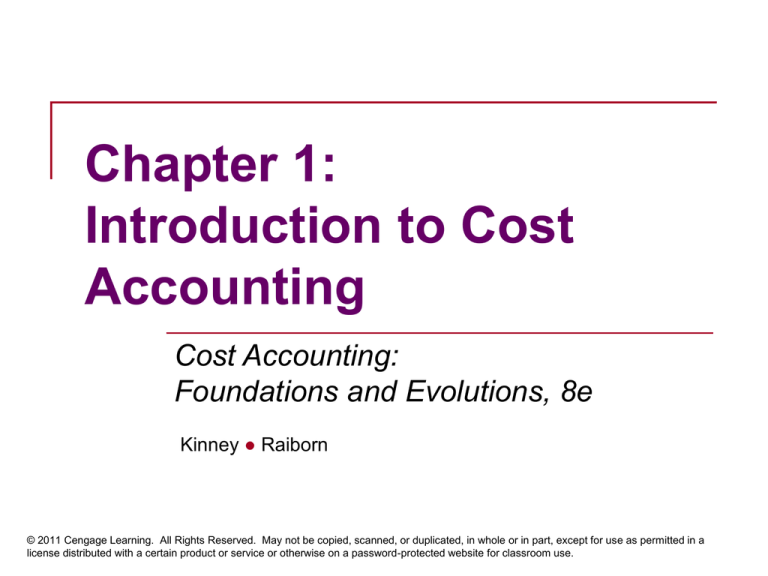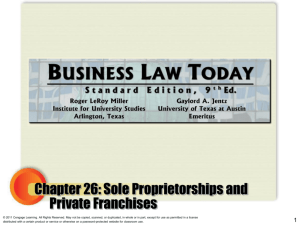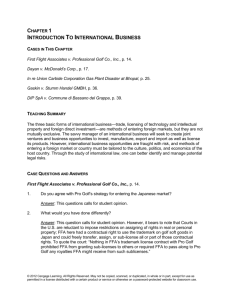
Chapter 1:
Introduction to Cost
Accounting
Cost Accounting:
Foundations and Evolutions, 8e
Kinney ● Raiborn
© 2011 Cengage Learning. All Rights Reserved. May not be copied, scanned, or duplicated, in whole or in part, except for use as permitted in a
license distributed with a certain product or service or otherwise on a password-protected website for classroom use.
Learning Objectives
What are the relationships among financial, management, and cost
accounting?
What are the the sources of authoritative pronouncements for the
practice of cost accounting?
What are the sources of ethical standards for cost accountants?
What is a mission statement, and why is it important to
organizational strategy?
What must accountants understand about an organization’s
structure and business environment in order to perform effectively in
that organization?
What is a value chain, and what are the major value chain
functions?
How is a balanced scorecard used to implement an organization’s
strategy?
Why is ethical behavior so important in organizations?
© 2011 Cengage Learning. All Rights Reserved. May not be copied, scanned, or duplicated, in whole or in part, except for use as permitted in
a license distributed with a certain product or service or otherwise on a password-protected website for classroom use.
Accountants
Financial accountants provide information to
external parties
Managerial accountants provide information to
internal users
Investors
Creditors
Regulators
Managers
Cost accountants provide information to both
internal and external users
Product cost information
Accounting is the language of business.
© 2011 Cengage Learning. All Rights Reserved. May not be copied, scanned, or duplicated, in whole or in part, except for use as permitted in
a license distributed with a certain product or service or otherwise on a password-protected website for classroom use.
Relationship of Financial,
Management, and Cost Accounting
Product
Costs
FINANCIAL
ACCOUNTING
COST
MANAGEMENT
ACCOUNTIN ACCOUNTING
G
© 2011 Cengage Learning. All Rights Reserved. May not be copied, scanned, or duplicated, in whole or in part, except for use as permitted in
a license distributed with a certain product or service or otherwise on a password-protected website for classroom use.
Types of Accounting
Financial
Meet external
information needs
Comply with GAAP
Management
Meet internal
information needs
Does not have to
comply with GAAP
© 2011 Cengage Learning. All Rights Reserved. May not be copied, scanned, or duplicated, in whole or in part, except for use as permitted in
a license distributed with a certain product or service or otherwise on a password-protected website for classroom use.
Financial versus Managerial
Financial
External focus
Whole organization
Historical
Quantitative
Monetary
Verifiable
GAAP
Formal recordkeeping
Managerial
Internal focus
Segments or divisions
Current/projected
Quantitative/qualitative
Monetary and nonmonetary
Timely/reasonable estimate
Benefits exceed costs
Formal and informal
recordkeeping
© 2011 Cengage Learning. All Rights Reserved. May not be copied, scanned, or duplicated, in whole or in part, except for use as permitted in
a license distributed with a certain product or service or otherwise on a password-protected website for classroom use.
Product Cost Information
External parties—stockholders, creditors, and
regulators
For investment and credit decisions
Complies with GAAP
Enterprise focus
Internal parties
Planning, controlling, and decision making
Evaluating performance
Includes upstream and downstream costs
Disaggregated
© 2011 Cengage Learning. All Rights Reserved. May not be copied, scanned, or duplicated, in whole or in part, except for use as permitted in
a license distributed with a certain product or service or otherwise on a password-protected website for classroom use.
Accounting Bodies
Financial
Public Company
Accounting Oversight
Board (PCAOB)
Securities and
Exchange Commission
(SEC)
Financial Accounting
Standards Board
(FASB)
Management
Institute of
Management
Accountants (IMA)
Society of Management
Accountants of Canada
Cost Accounting
Standards Board
(CASB)
© 2011 Cengage Learning. All Rights Reserved. May not be copied, scanned, or duplicated, in whole or in part, except for use as permitted in
a license distributed with a certain product or service or otherwise on a password-protected website for classroom use.
Management Accounting
Organizations
IMA
Statements on Management Accounting
(not legally binding)
Society of Management Accountants of
Canada
Management Accounting Guidelines
(not legally binding)
Cost Accounting Standards Board (CASB)
Government contracting standards
(legally binding)
© 2011 Cengage Learning. All Rights Reserved. May not be copied, scanned, or duplicated, in whole or in part, except for use as permitted in
a license distributed with a certain product or service or otherwise on a password-protected website for classroom use.
Professional Ethics
Earnings management—deliberate
accounting adjustments to “hit” profit targets
Often adjustments involve cost accounting
Product costs
Inventory valuations
Stretching legitimate accounting techniques
Outright fraud
© 2011 Cengage Learning. All Rights Reserved. May not be copied, scanned, or duplicated, in whole or in part, except for use as permitted in
a license distributed with a certain product or service or otherwise on a password-protected website for classroom use.
Ethics and Legislation
Sarbanes-Oxley Act—CEOs and CFOs
personally accountable for the accuracy of
their organization’s financial reporting
False Claims Act—whistle-blower protection
and penalties for failure to blow the whistle
(disclose known financial frauds)
© 2011 Cengage Learning. All Rights Reserved. May not be copied, scanned, or duplicated, in whole or in part, except for use as permitted in
a license distributed with a certain product or service or otherwise on a password-protected website for classroom use.
Ethics and Management Accounting
Standards of Ethical Conduct for
Management Accountants
Competence
Confidentiality
Integrity
Credibility
© 2011 Cengage Learning. All Rights Reserved. May not be copied, scanned, or duplicated, in whole or in part, except for use as permitted in
a license distributed with a certain product or service or otherwise on a password-protected website for classroom use.
Organizational Strategy
1. Develop mission statement
2. Implement strategy
3. Deploy resources to create value for
customers and shareholders
4. Recognize that each organization is
unique—thus unique strategies must be
developed
© 2011 Cengage Learning. All Rights Reserved. May not be copied, scanned, or duplicated, in whole or in part, except for use as permitted in
a license distributed with a certain product or service or otherwise on a password-protected website for classroom use.
Organizational Strategy
1. Develop mission statement
2. Implement strategy
Establish
appropriate
measures of
accomplishment
Develop,
implement, and
monitor
necessary
information
systems
© 2011 Cengage Learning. All Rights Reserved. May not be copied, scanned, or duplicated, in whole or in part, except for use as permitted in
a license distributed with a certain product or service or otherwise on a password-protected website for classroom use.
Five Factors in Organizational
Strategy
Core competencies
Organizational structure
Management style and organizational culture
Organizational constraints
Environmental constraints
© 2011 Cengage Learning. All Rights Reserved. May not be copied, scanned, or duplicated, in whole or in part, except for use as permitted in
a license distributed with a certain product or service or otherwise on a password-protected website for classroom use.
Organizational Strategies
Core competency—critical function or
activity providing a competitive advantage
Cost leadership strategy—undercut
competitor prices
Product differentiation strategy—superior
quality products or unique services sold at
a premium
© 2011 Cengage Learning. All Rights Reserved. May not be copied, scanned, or duplicated, in whole or in part, except for use as permitted in
a license distributed with a certain product or service or otherwise on a password-protected website for classroom use.
Strategy Questions
Who are your five most important
competitors?
Is your firm more or less profitable
than these firms?
Compare prices for equivalent
products/services.
Are they higher or lower? Explain
the difference. Is it customers,
costs, or profit requirements?
Are your costs higher or lower than
those of main competitors? Where
are the differences most
pronounced?
What segment(s) of your business
represents 80% profits?
For each business segment above,
how large are you relative to the
largest competitors? Are you gaining
or losing relative market share?
What are your customers’ most
important purchase criteria?
How do you and your competitors
rate on these purchase criteria?
What are your main strengths and
competencies? Are they appreciated
by the market?
Which are your priority segments?
Where is it most important that you
gain market share?
What is your competitive
advantage?
© 2011 Cengage Learning. All Rights Reserved. May not be copied, scanned, or duplicated, in whole or in part, except for use as permitted in
a license distributed with a certain product or service or otherwise on a password-protected website for classroom use.
Organizational Structure
Distribution of authority and responsibility in an
organization
Authority—right to use resources to accomplish a
task or achieve an objective
Responsibility—obligation to accomplish a task or
achieve an objective
Line manager works directly toward attaining
organizational goals
Staff employees give assistance and advice to line
managers
Treasurer and Controller
© 2011 Cengage Learning. All Rights Reserved. May not be copied, scanned, or duplicated, in whole or in part, except for use as permitted in
a license distributed with a certain product or service or otherwise on a password-protected website for classroom use.
Value Chain
A set of value-adding functions and
processes that converts inputs into
products or services
Research and
Development
Product Design
Supply
Production
Marketing
Distribution
Customer Service
Communicate strategy to all members of the value chain.
© 2011 Cengage Learning. All Rights Reserved. May not be copied, scanned, or duplicated, in whole or in part, except for use as permitted in
a license distributed with a certain product or service or otherwise on a password-protected website for classroom use.
Components of the Value Chain
© 2011 Cengage Learning. All Rights Reserved. May not be copied, scanned, or duplicated, in whole or in part, except for use as permitted in
a license distributed with a certain product or service or otherwise on a password-protected website for classroom use.
Balanced Scorecard
© 2011 Cengage Learning. All Rights Reserved. May not be copied, scanned, or duplicated, in whole or in part, except for use as permitted in
a license distributed with a certain product or service or otherwise on a password-protected website for classroom use.
Balanced Scorecard Perspectives
Learning and Growth
Internal Business
Things to do well to meet customer needs and expectations
Customer Value
Use the organization’s intellectual capital to adapt to changing
customer needs or to influence new customers’ needs and
expectations through product or service innovations
How well the organization is doing relative to important
customer criteria
Financial
Address stockholders/stakeholders concerns about profitability
and organizational growth
© 2011 Cengage Learning. All Rights Reserved. May not be copied, scanned, or duplicated, in whole or in part, except for use as permitted in
a license distributed with a certain product or service or otherwise on a password-protected website for classroom use.
Balanced Scorecard Measures
Short-term and long-term
Internal and external
Financial and nonfinancial
© 2011 Cengage Learning. All Rights Reserved. May not be copied, scanned, or duplicated, in whole or in part, except for use as permitted in
a license distributed with a certain product or service or otherwise on a password-protected website for classroom use.
Ethics in Multinationals
Foreign Corrupt Practices Act—prohibits
bribes to obtain/retain business
Organization of Economic Cooperation and
Development Convention—crime to offer,
promise, give bribes to obtain/retain internal
business deals
© 2011 Cengage Learning. All Rights Reserved. May not be copied, scanned, or duplicated, in whole or in part, except for use as permitted in
a license distributed with a certain product or service or otherwise on a password-protected website for classroom use.
Questions
What is the relationship among financial,
management, and cost accounting?
How is the balanced scorecard used to
implement an organization’s strategy?
Where can an accountant find ethical
standards for cost accounting?
© 2011 Cengage Learning. All Rights Reserved. May not be copied, scanned, or duplicated, in whole or in part, except for use as permitted in
a license distributed with a certain product or service or otherwise on a password-protected website for classroom use.
Potential Ethical Issues
Earnings management
Low-cost production at any cost
Whistle-blower retaliation
Fixing prices
Bribery and other corruption
Hiding managerial acts
© 2011 Cengage Learning. All Rights Reserved. May not be copied, scanned, or duplicated, in whole or in part, except for use as permitted in
a license distributed with a certain product or service or otherwise on a password-protected website for classroom use.







